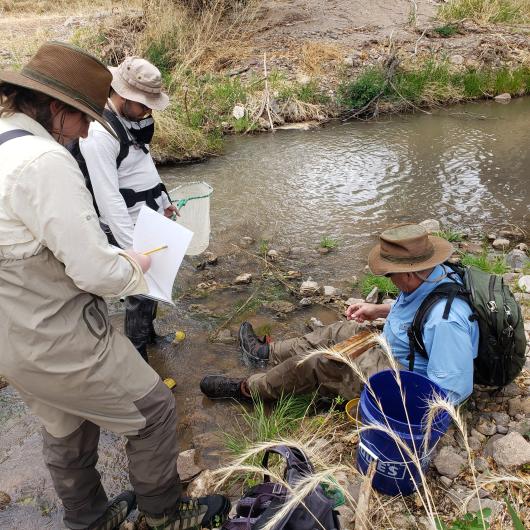BLM to invest $3.1 million to restore wildlife habitats, as part of the Investing in America agenda
Organization:
Media Contact:
WASHINGTON – The Bureau of Land Management (BLM) announced today a $3.1 million investment from the Bipartisan Infrastructure Law to restore wildlife habitat areas in six western states. This funding is part of the Biden-Harris Administration’s Investing in America agenda, which is creating good-paying jobs, advancing climate resilience and restoring our nation’s lands and waters in partnership with Tribes, private landowners, hunting and conservation organizations, and state wildlife management agencies.
“These investments will provide direct and lasting benefits to the public lands we enjoy,” said BLM Director Tracy Stone-Manning. “The work accomplished in these locations will boost the economy and the ecosystem, benefitting communities nearby for many years to come.”
The Bureau will pursue contracting opportunities over the next several months in the following locations:
- ARIZONA: San Pedro Riparian National Conservation Area (NCA) and Watershed, Cochise County. The San Pedro Riparian NCA is a rare remnant riparian system in the Southwest, that with sufficient water resources offers refuge for desert wildlife and numerous recreational opportunities. BLM is aiming to build drought resilience in this arid watershed.
- CALIFORNIA: Santa Ana Wash Area of Critical Environmental Concern and Watershed, San Bernardino County. BLM is aiming to restore critical habitat areas for the endangered slender-horned spineflower and San Bernardino kangaroo rat. The Santa Ana Wash is also regionally important for flood control, groundwater recharge, and recreation.
- CALIFORNIA: Salton Sea Watershed, Riverside County. Thanks to BLM’s efforts over 30 years to protect the habitat for the Stephens’ kangaroo rat, the species has partially recovered and was reclassified from endangered to threatened. This project will continue recovery actions to benefit the species.
- UTAH: Pariette Wetlands Habitat Management Area and Pariette Wash Watershed, Uintah County. The Pariette Wetlands is an oasis in the Uinta Basin, providing refuge to critical wildlife amidst surrounding desert lands, particularly for migrating and resident birds and waterfowl. BLM intends to repair critical infrastructure to maintain the wetland to benefit sensitive biological communities.
- ARIZONA: Gila Box Riparian National Conservation Area, Greenlee County. BLM will conduct streamflow gauging to revise instream flow rights so that adequate water resources can be ensured for dependent flora and fauna and for recreation in the Gila Box Riparian Conservation Area. The area includes perennial waterways abundant with plant and animal diversity and is important for prehistoric and cultural sites and recreation opportunities.
- MONTANA: Rock Creek Watershed, Granite County. BLM will reconnect many miles of stream floodplain to support riparian areas and wet meadows in Upper Rock Creek, a blue-ribbon fishing stream. The effort is expected to increase instream habitat complexity and water retention critical for rearing native fish and increasing water and sediment retention.
- WYOMING: Dry Piney Creek Watershed, Sublette County. BLM is actively working in Sublette County to increase floodplain connectivity in Dry Piney Creek. This project will reduce stream downcutting and erosion.
- MONTANA: Public lands in Petroleum County. BLM will inventory and treat sulphur cinquefoil, spotted knapweed, Russian knapweed, and leafy spurge throughout the county. These aggressive invasive species crowd-out native vegetation and increase wildfire risk in the sagebrush ecosystem, a habitat of critical importance for the sage-grouse.
- CALIFORNIA: Great Basin Desert, Lahontan Watershed. BLM will remove invasive annual grasses throughout the watershed, then re-seed with native species to restore core sage grouse habitats and improve ecosystem function. The Lahontan Watershed is located in a Sagebrush Collaborative Restoration Landscape area encompassing parts of California, Nevada and Oregon under DOI’s Sagebrush Keystone Initiative.
- NEVADA: Bull Creek Watershed, Washoe County, NV. BLM will remove and control invasive annual grasses and encroaching conifers across high-elevation sagebrush ecosystems in Bull Creek in Northwestern Nevada. Treatments are intended to remove competition for native tree and shrub species. BLM California has administrative responsibilities for this project.
- COLORADO: Dry Creek Basin, San Miguel County. BLM will concentrate efforts on reducing downcutting and erosion along a mile-long stretch of the West Fork of Dry Creek. These efforts aim to improve habitat conditions for sage-grouse and other wildlife. The area is adjacent to the Dry Creek Basin State Wildlife Area.
The BLM manages about 245 million acres of public land located primarily in 12 western states, including Alaska, on behalf of the American people. The BLM also administers 700 million acres of sub-surface mineral estate throughout the nation. Our mission is to sustain the health, diversity, and productivity of America’s public lands for the use and enjoyment of present and future generations.

